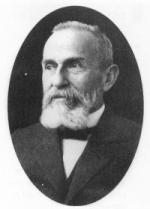Schizophrenia
For patient information click here
| Schizophrenia | ||
 | ||
|---|---|---|
| Eugen Bleuler (1857–1939) coined the term "Schizophrenia" in 1908 | ||
| ICD-10 | F20 | |
| ICD-9 | 295 | |
| OMIM | 181500 | |
| DiseasesDB | 11890 | |
| MedlinePlus | 000928 | |
| MeSH | F03.700.750 | |
|
Schizophrenia Microchapters |
|
Diagnosis |
|---|
|
Treatment |
|
Case Studies |
|
Schizophrenia On the Web |
|
American Roentgen Ray Society Images of Schizophrenia |
Editor-In-Chief: C. Michael Gibson, M.S., M.D. [1]
=
Treatment and services

The concept of a cure as such remains controversial, as there is no consensus on the definition, although some criteria for the remission of symptoms have recently been suggested.[1] The effectiveness of schizophrenia treatment is often assessed using standardized methods, one of the most common being the positive and negative syndrome scale (PANSS).[2] Management of symptoms and improving function is thought to be more achievable than a cure. Treatment was revolutionized in the mid 1950s with the development and introduction of chlorpromazine.[3] A recovery model is increasingly adopted, emphasizing hope, empowerment and social inclusion.[4]
Hospitalization may occur with severe episodes of schizophrenia. This can be voluntary or (if mental health legislation allows it) involuntary (called civil or involuntary commitment). Long-term inpatient stays are now less common due to deinstitutionalization, although can still occur.[5] Following (or in lieu of) a hospital admission, support services available can include drop-in centers, visits from members of a community mental health team or Assertive Community Treatment team, supported employment[6] and patient-led support groups.
In many non-Western societies, schizophrenia may only be treated with more informal, community-led methods. The outcome for people diagnosed with schizophrenia in non-Western countries may actually be better than for people in the West.[7] The reasons for this effect are not clear, although cross-cultural studies are being conducted.
References
- ↑ van Os J, Burns T, Cavallaro R, et al (2006). Standardized remission criteria in schizophrenia. Acta Psychiatrica Scandinavica, 113(2), 91–5. PMID 16423159
- ↑ Kay SR, Fiszbein A, Opler LA (1987). The positive and negative syndrome scale (PANSS) for schizophrenia. Schizophrenia Bulletin, 13(2), 261–76. PMID 3616518
- ↑ Turner T. (2007). "Unlocking psychosis". Brit J Med. 334 (suppl): s7.
- ↑ Bellack AS. (2006) Scientific and consumer models of recovery in schizophrenia: concordance, contrasts, and implications. Schizophr Bull. Jul;32(3):432-42. PMID 16461575
- ↑ Becker T, Kilian R. (2006) Psychiatric services for people with severe mental illness across western Europe: what can be generalized from current knowledge about differences in provision, costs and outcomes of mental health care? Acta Psychiatrica Scandinavica Supplement, 429, 9–16. PMID 16445476
- ↑ McGurk, SR, Mueser KT, Feldman K, Wolfe R, Pascaris A (2007). Cognitive training for supported employment: 2–3 year outcomes of a randomized controlled trial. Am J Psychiatry. Mar;164(3):437–41. PMID 17329468
- ↑ Kulhara P (1994). Outcome of schizophrenia: some transcultural observations with particular reference to developing countries. European Archives of Psychiatry and Clinical Neuroscience, 244(5), 227–35. PMID 7893767
Further reading
- Bentall, R. (2003) Madness explained: Psychosis and Human Nature. London: Penguin Books Ltd. ISBN 0-7139-9249-2
- Fallon, James H. et al. (2003) The Neuroanatomy of Schizophrenia: Circuitry and Neurotransmitter Systems. Clinical Neuroscience Research 3:77–107. Available at Elsevier article locater.
- Green, M.F. (2001) Schizophrenia Revealed: From Neurons to Social Interactions. New York: W.W. Norton. ISBN 0-393-70334-7
- Keen, T. M. (1999) Schizophrenia: orthodoxy and heresies. A review of alternative possibilities. Journal of Psychiatric and Mental Health Nursing, 1999, 6, 415–424. PMID 10818864
- Lidz, Theodore, Stephen Fleck & Alice Cornelison, Schizophrenia and the Family. International Universities Press, 1965. ISBN 978-0823660018
- Noll, Richard (2007) The Encyclopedia of Schizophrenia and Other Psychotic Disorders, Third Edition ISBN 0-8160-6405-9
- Open The Doors - information on global programme to fight stigma and discrimination because of Schizophrenia. The World Psychiatric Association (WPA)
- Read, J., Mosher, L.R., Bentall, R. (2004) Models of Madness: Psychological, Social and Biological Approaches to Schizophrenia. ISBN 1-58391-906-6. A critical approach to biological and genetic theories, and a review of social influences on schizophrenia.
- Scientific American Magazine (January 2004 Issue) Decoding Schizophrenia
- Shaner, A., Miller, G. F., & Mintz, J. (2004). Schizophrenia as one extreme of a sexually selected fitness indicator. Schizophrenia Research, 70(1), 101–109. PMID 15246469Full text (PDF), Retrieved on 2007-05-17.
- Szasz, T. (1976) Schizophrenia: The Sacred Symbol of Psychiatry. New York: Basic Books. ISBN 0-465-07222-4
- Tausk, V. : "Sexuality, War, and Schizophrenia: Collected Psychoanalytic Papers", Publisher: Transaction Publishers 1991, ISBN 0-88738-365-3 (On the Origin of the 'Influencing Machine' in Schizophrenia.)
- Wiencke, Markus (2006) Schizophrenie als Ergebnis von Wechselwirkungen: Georg Simmels Individualitätskonzept in der Klinischen Psychologie. In David Kim (ed.), Georg Simmel in Translation: Interdisciplinary Border-Crossings in Culture and Modernity (pp. 123–155). Cambridge Scholars Press, Cambridge, ISBN 1-84718-060-5
ar:فصام
bs:Shizofrenija
bg:Шизофрения
ca:Esquizofrènia
cs:Schizofrenie
da:Skizofreni
de:Schizophrenie
et:Skisofreenia
eo:Skizofrenio
fa:روانگسیختگی
gl:Esquizofrenia
ko:정신분열증
hr:Shizofrenija
io:Skizofrenio
id:Skizofrenia
ia:Schizophrenia
is:Geðklofi
it:Schizofrenia
he:סכיזופרניה
kl:Skizofrenii
ku:Şîzofrenî
la:Morbus dissidentiae phreneticae
lt:Šizofrenija
hu:Skizofrénia
ms:Skizofrenia
nl:Schizofrenie
no:Schizofreni
qu:Waq'akay
simple:Schizophrenia
sk:Schizofrénia
sr:Схизофренија
sh:Shizofrenija
fi:Skitsofrenia
sv:Schizofreni
uk:Шизофренія
ur:انفصام